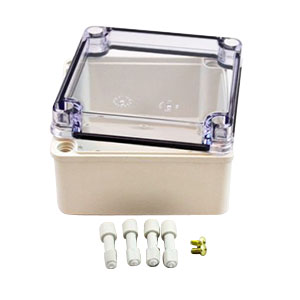Purchasing a harsh environment enclosure can be a tricky business. The components need to be protected but it is also important not to overkill the protection and waste costs. All too often, the enclosure is not considered until the last minute in any design, the focus going on the active components. This can lead to a quick decision that often negates many cost savings in other areas. Therefore, we have developed five ways to save money on your harsh environment enclosure purchase that will also allow you to be better prepared and best of all, save money.

BUD’s PTS series is a low cost IP67 enclosure
1. As simple as it seems, use a standard enclosure.
In the rush to enclose the product, the quick response is for an exact match to engineering specs. However, by choosing a standard, off the shelf, enclosure, the lead time and cost both decline significantly. It is important to remember that using a slightly larger enclosure does not impact the functioning of the internal components, so buying a box that is an inch larger could actually save money if it is a standard compared to the costs of developing the requested custom box. This is particularly true when buying plastic enclosures with significant tooling costs.
2. Consider using a less expensive material.
As an example, steel or aluminum are more expensive than plastic. In the United States, for NEMA/IP rated enclosures, steel is the preferred material. In the rest of the world, plastics are more popular in no small part due to their low cost and more than adequate strength. If the application does not require the box to withstand constant physical abuse, plastic provides a lower cost and even more corrosion resistant option.
3. Do you need specific ratings on the enclosure or can you utilize the unit without those ratings?
For example, does the unit need a UL rating or is the manufacturer’s NEMA ratings sufficient? For example, Bud offers a NEMA/IP rated enclosure line with several alternatives included an ABS plastic version that does not come with the UL ratings. For most applications, this box provides a perfect combination of value and function. In a similar vein, can you use a box with a lower level of protection? For example, a NEMA 1 box may suffice where traditionally one has used a NEMA 12 box. Alternatively, if only a specific internal component needs to be EMI/RFI shielded, it is better to protect that component than to shield the entire enclosure.
4. Review which accessories are included so that the price comparisons are accurate.
Some manufacturer’s offer a turn-key enclosure such as having mounting panels included in NEMA steel or plastic boxes, mounting provisions for wall mounting or equipment mounting an enclosure, and bails or handles for easy maneuverability. Consideration of these features can save significant cost and also insure that all components work well together.
5. If modifications are required, consider having them done at the manufacturer.
The manufacturer knows the best approaches for drilling or punching based on the product materials and can avoid cracking or chipping the box itself. It avoids having to find a local source for the work, saving time and potential damage in multiple shipments of the product. The manufacturer can provide a turn-key product, speeding installation of the components and providing a rapid up-time.
Nothing is more frustrating than paying more than is necessary for a quality harsh environment enclosure. With these steps, you can insure that your project does not cost more than it should or slow down your work. Don’t overlook the simple solutions to your complex problems.


